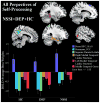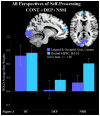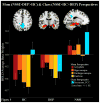The neurobiology of self-knowledge in depressed and self-injurious youth
- PMID: 27442923
- PMCID: PMC5737906
- DOI: 10.1016/j.pscychresns.2016.06.015
The neurobiology of self-knowledge in depressed and self-injurious youth
Abstract
There is limited information regarding the neurobiology underlying non-suicidal self-injury (NSSI) in clinically-referred youth. However, the salience of disturbed interpersonal relationships and disrupted self-processing associated with NSSI suggests the neural basis of social processes as a key area for additional study. Adolescent participants (N=123; M=14.75 years, SD=1.64) were divided into three groups: NSSI plus depression diagnosis (NSSI), depression only (DEP), healthy controls (HC). In the scanner, participants completed an Interpersonal Self-Processing task by taking direct (own) and indirect (mothers', best friends', or classmates') perspectives regarding self-characteristics. Across all perspectives, NSSI showed higher BOLD activation in limbic areas, and anterior and posterior cortical midline structures versus DEP and HC, while HC showed greater activity in rostrolateral, frontal pole and occipital cortex than NSSI and DEP youth. Moreover, NSSI youth showed heightened responses in amygdala, hippocampus, parahippocampus, and fusiform when taking their mothers' perspective, which were negatively correlated with self-reports of the mother's support of adolescents' emotional distress in the NSSI group. NSSI youth also yielded greater precuneus and posterior cingulate cortex activity during indirect self-processing from their classmates' perspective. Findings suggest a role for disruptions in self- and emotion-processing, and conflicted social relationships in the neurobiology of NSSI among depressed adolescents.
Keywords: Adolescence; Depression; Emotional invalidation; Limbic and cortical midline structures; Neuroimaging; Non-suicidal self-injury; Self-knowledge.
Copyright © 2016 Elsevier Ireland Ltd. All rights reserved.
Figures




Similar articles
-
Neural Correlates Associated With Suicide and Nonsuicidal Self-injury in Youth.Biol Psychiatry. 2021 Jan 15;89(2):119-133. doi: 10.1016/j.biopsych.2020.06.002. Epub 2020 Jun 10. Biol Psychiatry. 2021. PMID: 32782140 Free PMC article. Review.
-
The neurobiology of self face recognition among depressed adolescents.J Affect Disord. 2018 Mar 15;229:22-31. doi: 10.1016/j.jad.2017.12.023. Epub 2017 Dec 28. J Affect Disord. 2018. PMID: 29304386 Free PMC article.
-
Prone to excitement: adolescent females with Non-suicidal self-injury (NSSI) show altered cortical pattern to emotional and NSS-related material.Psychiatry Res. 2012 Aug-Sep;203(2-3):146-52. doi: 10.1016/j.pscychresns.2011.12.012. Epub 2012 Aug 16. Psychiatry Res. 2012. PMID: 22901627
-
Multi-modal neuroimaging of adolescents with non-suicidal self-injury: Amygdala functional connectivity.J Affect Disord. 2017 Oct 15;221:47-55. doi: 10.1016/j.jad.2017.06.004. Epub 2017 Jun 13. J Affect Disord. 2017. PMID: 28628767 Free PMC article.
-
Non-suicidal self-injury in trans people: associations with psychological symptoms, victimization, interpersonal functioning, and perceived social support.J Sex Med. 2015 Jan;12(1):168-79. doi: 10.1111/jsm.12711. Epub 2014 Oct 6. J Sex Med. 2015. PMID: 25283073 Review.
Cited by
-
Disruption of Neural Activity and Functional Connectivity in Adolescents With Major Depressive Disorder Who Engage in Non-suicidal Self-Injury: A Resting-State fMRI Study.Front Psychiatry. 2021 Jun 1;12:571532. doi: 10.3389/fpsyt.2021.571532. eCollection 2021. Front Psychiatry. 2021. PMID: 34140897 Free PMC article.
-
Potential mechanisms of non-suicidal self-injury (NSSI) in major depressive disorder: a systematic review.Gen Psychiatr. 2023 Aug 29;36(4):e100946. doi: 10.1136/gpsych-2022-100946. eCollection 2023. Gen Psychiatr. 2023. PMID: 37655114 Free PMC article.
-
Neural Correlates Associated With Suicide and Nonsuicidal Self-injury in Youth.Biol Psychiatry. 2021 Jan 15;89(2):119-133. doi: 10.1016/j.biopsych.2020.06.002. Epub 2020 Jun 10. Biol Psychiatry. 2021. PMID: 32782140 Free PMC article. Review.
-
The Development of Self and Identity in Adolescence: Neural Evidence and Implications for a Value-Based Choice Perspective on Motivated Behavior.Child Dev Perspect. 2018 Sep;12(3):158-164. doi: 10.1111/cdep.12279. Epub 2018 Feb 8. Child Dev Perspect. 2018. PMID: 31363361 Free PMC article.
-
Understanding the emergence of suicidal thoughts and behaviors in adolescence from a brain and behavioral developmental perspective.Neuropsychopharmacology. 2025 Jul 25. doi: 10.1038/s41386-025-02168-2. Online ahead of print. Neuropsychopharmacology. 2025. PMID: 40715769 Review.
References
-
- Adolphs R, Spezio M. Role of the amygdala in visual social stimuli Progress in Brain Research. 2006;156:363–378. - PubMed
-
- Adrian M, Zeman J, Erdley C, Lisa L, Sim L. Emotional dysregulation and interpersonal difficulties as risk factors for nonsuicidal self-injury in adolescent girls. J Abnorm Child Psychol. 2011;39:389–400. - PubMed
-
- Allison T, Puce A, McCarthy G. Social perception from visual cues: Role of the STS region. Trends in Cognitive Neurosciences. 2000;4:267–278. - PubMed
-
- Amodio DM, Frith CD. Meeting of minds: the medial frontal cortex and social cognition. Nat Rev Neurosci. 2006;7:268–277. - PubMed
MeSH terms
Grants and funding
LinkOut - more resources
Full Text Sources
Other Literature Sources
Medical

